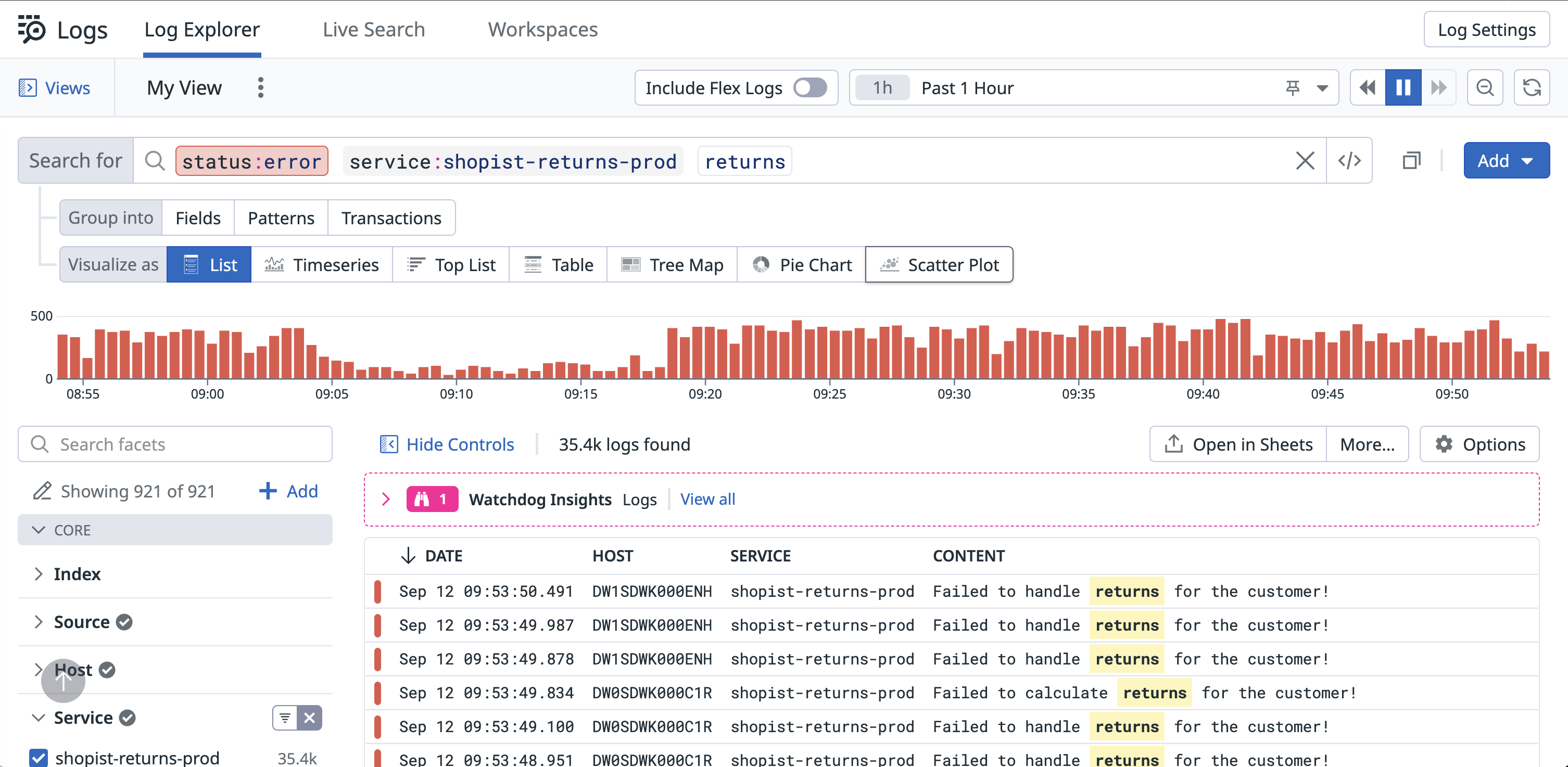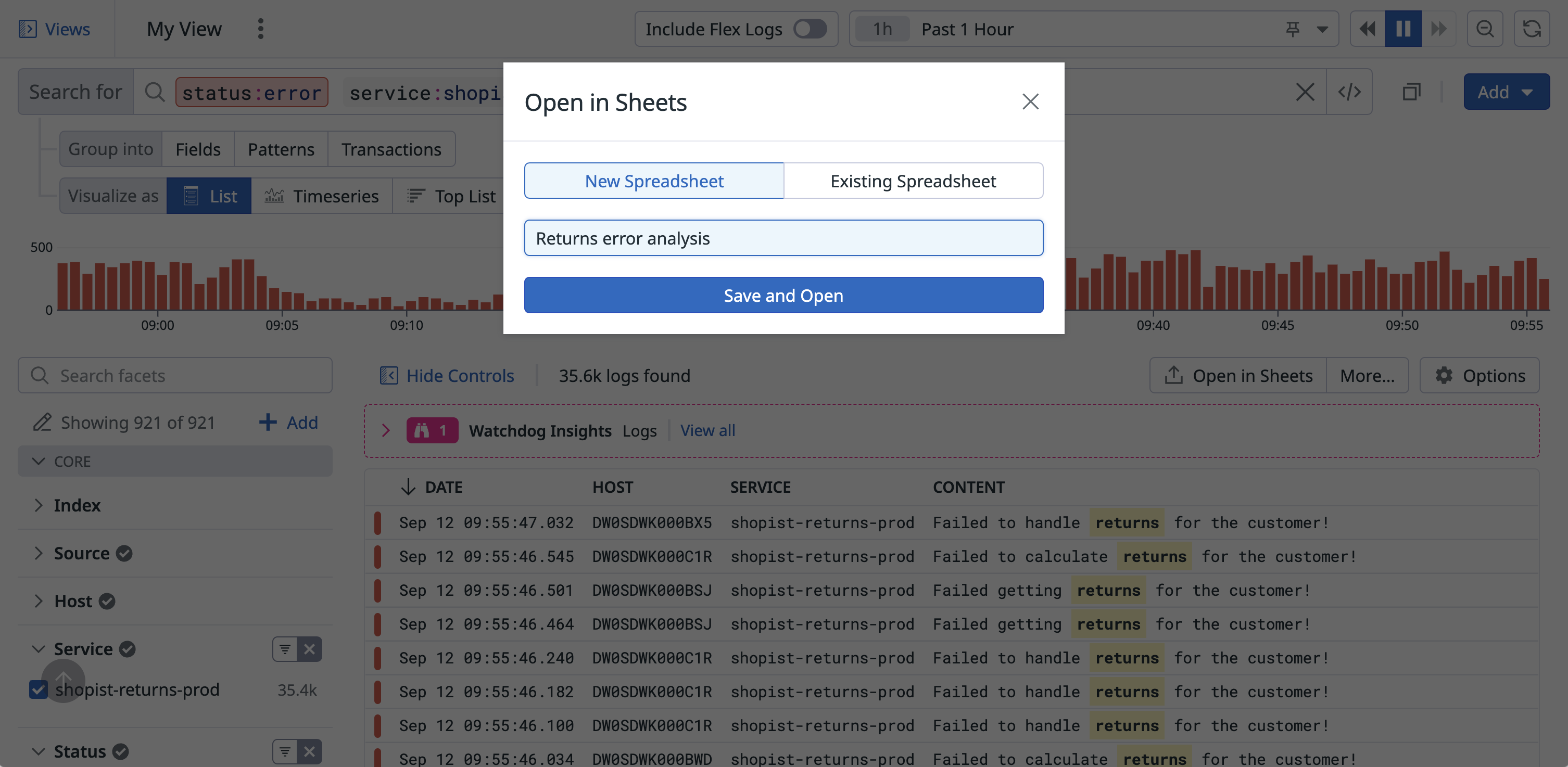- Esenciales
- Empezando
- Agent
- API
- Rastreo de APM
- Contenedores
- Dashboards
- Monitorización de bases de datos
- Datadog
- Sitio web de Datadog
- DevSecOps
- Gestión de incidencias
- Integraciones
- Internal Developer Portal
- Logs
- Monitores
- OpenTelemetry
- Generador de perfiles
- Session Replay
- Security
- Serverless para Lambda AWS
- Software Delivery
- Monitorización Synthetic
- Etiquetas (tags)
- Workflow Automation
- Centro de aprendizaje
- Compatibilidad
- Glosario
- Atributos estándar
- Guías
- Agent
- Arquitectura
- IoT
- Plataformas compatibles
- Recopilación de logs
- Configuración
- Automatización de flotas
- Solucionar problemas
- Detección de nombres de host en contenedores
- Modo de depuración
- Flare del Agent
- Estado del check del Agent
- Problemas de NTP
- Problemas de permisos
- Problemas de integraciones
- Problemas del sitio
- Problemas de Autodiscovery
- Problemas de contenedores de Windows
- Configuración del tiempo de ejecución del Agent
- Consumo elevado de memoria o CPU
- Guías
- Seguridad de datos
- Integraciones
- Desarrolladores
- Autorización
- DogStatsD
- Checks personalizados
- Integraciones
- Build an Integration with Datadog
- Crear una integración basada en el Agent
- Crear una integración API
- Crear un pipeline de logs
- Referencia de activos de integración
- Crear una oferta de mercado
- Crear un dashboard de integración
- Create a Monitor Template
- Crear una regla de detección Cloud SIEM
- Instalar la herramienta de desarrollo de integraciones del Agente
- Checks de servicio
- Complementos de IDE
- Comunidad
- Guías
- OpenTelemetry
- Administrator's Guide
- API
- Partners
- Aplicación móvil de Datadog
- DDSQL Reference
- CoScreen
- CoTerm
- Remote Configuration
- Cloudcraft
- En la aplicación
- Dashboards
- Notebooks
- Editor DDSQL
- Reference Tables
- Hojas
- Monitores y alertas
- Watchdog
- Métricas
- Bits AI
- Internal Developer Portal
- Error Tracking
- Explorador
- Estados de problemas
- Detección de regresión
- Suspected Causes
- Error Grouping
- Bits AI Dev Agent
- Monitores
- Issue Correlation
- Identificar confirmaciones sospechosas
- Auto Assign
- Issue Team Ownership
- Rastrear errores del navegador y móviles
- Rastrear errores de backend
- Manage Data Collection
- Solucionar problemas
- Guides
- Change Tracking
- Gestión de servicios
- Objetivos de nivel de servicio (SLOs)
- Gestión de incidentes
- De guardia
- Status Pages
- Gestión de eventos
- Gestión de casos
- Actions & Remediations
- Infraestructura
- Cloudcraft
- Catálogo de recursos
- Universal Service Monitoring
- Hosts
- Contenedores
- Processes
- Serverless
- Monitorización de red
- Cloud Cost
- Rendimiento de las aplicaciones
- APM
- Términos y conceptos de APM
- Instrumentación de aplicación
- Recopilación de métricas de APM
- Configuración de pipelines de trazas
- Correlacionar trazas (traces) y otros datos de telemetría
- Trace Explorer
- Recommendations
- Code Origin for Spans
- Observabilidad del servicio
- Endpoint Observability
- Instrumentación dinámica
- Live Debugger
- Error Tracking
- Seguridad de los datos
- Guías
- Solucionar problemas
- Límites de tasa del Agent
- Métricas de APM del Agent
- Uso de recursos del Agent
- Logs correlacionados
- Stacks tecnológicos de llamada en profundidad PHP 5
- Herramienta de diagnóstico de .NET
- Cuantificación de APM
- Go Compile-Time Instrumentation
- Logs de inicio del rastreador
- Logs de depuración del rastreador
- Errores de conexión
- Continuous Profiler
- Database Monitoring
- Gastos generales de integración del Agent
- Arquitecturas de configuración
- Configuración de Postgres
- Configuración de MySQL
- Configuración de SQL Server
- Configuración de Oracle
- Configuración de MongoDB
- Setting Up Amazon DocumentDB
- Conexión de DBM y trazas
- Datos recopilados
- Explorar hosts de bases de datos
- Explorar métricas de consultas
- Explorar ejemplos de consulta
- Exploring Database Schemas
- Exploring Recommendations
- Solucionar problemas
- Guías
- Data Streams Monitoring
- Data Jobs Monitoring
- Data Observability
- Experiencia digital
- Real User Monitoring
- Pruebas y monitorización de Synthetics
- Continuous Testing
- Análisis de productos
- Entrega de software
- CI Visibility
- CD Visibility
- Deployment Gates
- Test Visibility
- Configuración
- Network Settings
- Tests en contenedores
- Repositories
- Explorador
- Monitores
- Test Health
- Flaky Test Management
- Working with Flaky Tests
- Test Impact Analysis
- Flujos de trabajo de desarrolladores
- Cobertura de código
- Instrumentar tests de navegador con RUM
- Instrumentar tests de Swift con RUM
- Correlacionar logs y tests
- Guías
- Solucionar problemas
- Code Coverage
- Quality Gates
- Métricas de DORA
- Feature Flags
- Seguridad
- Información general de seguridad
- Cloud SIEM
- Code Security
- Cloud Security Management
- Application Security Management
- Workload Protection
- Sensitive Data Scanner
- Observabilidad de la IA
- Log Management
- Observability Pipelines
- Gestión de logs
- CloudPrem
- Administración
- Gestión de cuentas
- Seguridad de los datos
- Ayuda
Analizar logs de errores mediante Sheets
Información general
Datadog Sheets es una herramienta de hojas de cálculo que puedes completar con datos de Datadog para realizar análisis complejos y generar informes sin necesidad de conocimientos técnicos.
En esta guía se explica cómo crear una tabla de logs de errores, añadir columnas calculadas para extraer detalles de errores específicos de los mensajes de error y usar tablas dinámicas con el fin de resumir los datos e identificar patrones. También se ofrece un caso de uso de ejemplo de este flujo de trabajo.
Creación de una tabla en Sheets
- Comienza desde una página de producto compatible, como Log Explorer.
- Crea la consulta de datos que quieras analizar. Por ejemplo, para filtrar los logs y solo mostrar aquellos con
status:errorque contengan la palabra «returns» (devoluciones) en el mensaje de log:status:error service:shopist-returns-prod returns - Haz clic en Open in Sheets (Abrir en Sheets).
- Elige crear una New Spreadsheet (Hoja de cálculo nueva) o añadir la tabla a una Existing Spreadsheet (Hoja de cálculo existente).
- Haz clic en Save and Open (Guardar y abrir).
Adición de columnas calculadas
Para obtener más información sobre los errores de devolución, es posible que quieras extraer partes específicas de los mensajes de error. Puedes lograrlo al añadir columnas calculadas en Sheets.
- En el encabezado de la columna del extremo derecho de tu tabla, haz clic en el icono del signo más para añadir una columna calculada.
- Usa la función
REGEXEXTRACTpara extraer el problema real con la devolución. Por ejemplo, para extraer la siguiente palabra después de «Failed» (Error al) o «Failed to» (No se pudo):Esta función te ayuda a identificar si el error se encuentra en la obtención, cálculo o gestión de las devoluciones.=REGEXEXTRACT(#'Message', "Failed (?:to )?(\w+)")
Uso de tablas dinámicas para el análisis
Las tablas dinámicas te ayudan a resumir y organizar grandes conjuntos de datos para encontrar patrones y tendencias.
- En una hoja de cálculo existente que ya tenga una tabla de datos, haz clic en Add Pivot Table (Añadir tabla dinámica).
- En la sección Rows (Filas), selecciona las dimensiones que quieres analizar, como el estado de los logs.
- En la sección Calculations (Cálculos), elige las dimensiones para los cálculos, como suma, media, recuento, mínimo y máximo.
Caso de uso de ejemplo: Análisis de logs de errores de una aplicación para comercio minorista
Tienes una aplicación web para comercio minorista que genera una serie de logs de errores relacionados con returns (devoluciones). Quieres analizar qué tipos de errores causan estos problemas. Sigue estos pasos para analizar tus logs de errores, identificar patrones y obtener información sobre los problemas subyacentes que causan errores en tu aplicación para comercio minorista. Aplica este ejemplo a tus logs para comprenderlos mejor y tomar decisiones basadas en datos.
Logs de ejemplo
Failed getting returns for the customer!(¡No se pudieron obtener devoluciones para el cliente!)Failed to calculate returns for the customer!(¡No se pudo calcular las devoluciones para el cliente!)Failed to handle returns for the customer!(¡No se pudo gestionar las devoluciones para el cliente!)
Analizar logs de errores
- En Logs Explorer, crea una consulta de logs que filtre los logs de errores de tu aplicación para comercio minorista con
returns(devoluciones) en el mensaje de log. Por ejemplo:status:error service:shopist-returns-prod returns - Haz clic en Open in Sheets (Abrir en Sheets) para crear una tabla nueva a fin de analizar estos logs.
Extraer datos de errores específicos
Añade una columna calculada en Sheets para extraer el problema específico con la devolución mediante la función REGEXEXTRACT:
=REGEXEXTRACT(#'Message', "Failed (?:to )?(\w+)")
Analizar tipos de errores
- Crea una tabla dinámica para contar la cantidad de errores por tipo de error (
getting[obtención],calculating[cálculo] yhandling[gestión]). - Resume los datos para comprender la distribución y el impacto total de cada tipo de error.
Referencias adicionales
Más enlaces, artículos y documentación útiles:


